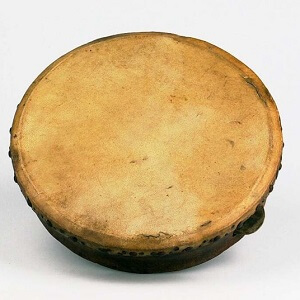Rebana
 The rebana is a single-head frame membranophone from the coastal region or the islands of Riau province, east central Sumatra, in the Indonesian archipelago. Such drums are part of the widespread Muslim Melayu culture of this area. Frame drums such as this large rebana are used to accompany ronggèng, dancing which in the past was associated with weddings, circumcisions, and other celebrations and included professional dancers with whom male celebrants could dance.
The rebana is a single-head frame membranophone from the coastal region or the islands of Riau province, east central Sumatra, in the Indonesian archipelago. Such drums are part of the widespread Muslim Melayu culture of this area. Frame drums such as this large rebana are used to accompany ronggèng, dancing which in the past was associated with weddings, circumcisions, and other celebrations and included professional dancers with whom male celebrants could dance.
The shallow shell is made from a hardwood and is conical--i.e., the skin covered opening is of a noticeably wider diameter than the bottom, uncovered opening. Indirect lacing is used to attach the mammal skin to the shell. The membrane is first stretched over and attached to a rattan ring. Another rattan ring is situated near the base of the shell and held in place by a groove carved into the shell itself. A sturdy mammal hide lace is then threaded around the two hoops, alternating between the top one and the bottom one, in a ‘V’ pattern.
Islam was introduced to Sumatra at the end of the 13th century and grew in cultural significance over the ensuing centuries, with Muslim kingdoms being established in the Malacca Straights region in the 1400s. It is most likely that frame drums such as the rebana were introduced to Sumatra during this period of Islamization of the Malay peoples. Wherever Islam has spread in the Indonesian archipelago one is almost certain to find some variant of the frame drum as part of religious and secular musical life.